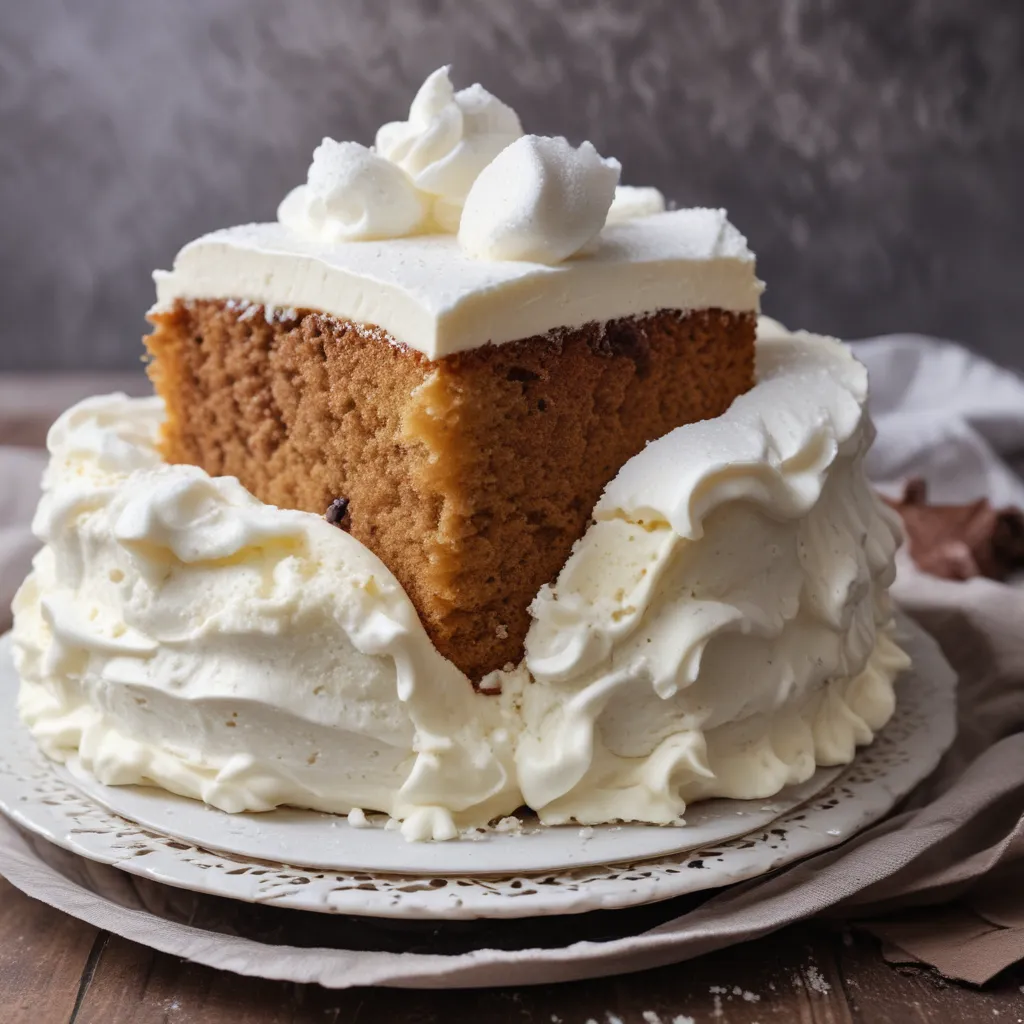Ah, the age-old conundrum of the missing ingredient. It’s like trying to bake a cake with one hand tied behind your back – just a tad bit challenging. But fear not, my fellow bakers! I’m here to share my hard-earned wisdom on the art of baking substitutions.
Why Bother with Substitutions?
Before we dive into the nitty-gritty, let’s address the elephant in the room – why even bother with substitutions in the first place? Well, my friends, the answer is simple: life happens. You know the drill. You’ve got a killer cake recipe all lined up, your apron is on, and you’re ready to get your bake on. But then, the unthinkable happens – you realize you’re out of that one crucial ingredient. Gasp! What’s a baker to do?
That’s where substitutions come in handy. They’re the culinary equivalent of a superhero cape, swooping in to save the day (and your baked goods) when disaster strikes. Think of it as a choose-your-own-adventure for your recipe – with a little creativity and some basic baking knowledge, you can keep on keepin’ on, even when your pantry is a bit sparse.
The Basics of Baking Substitutions
Alright, let’s get down to the nitty-gritty. The foundation of successful baking substitutions lies in understanding the role each ingredient plays in the recipe. Are you missing your trusty all-purpose flour? No problem! You can easily substitute it with a blend of whole wheat flour and cornstarch. Ran out of eggs? No need to panic – a flax or chia “egg” can work wonders.
The key is to find ingredients that can mimic the function of the missing one, whether it’s providing structure, moisture, or that all-important leavening action. It’s a bit like being a culinary detective, scouring your kitchen for clues and piecing together the perfect substitution puzzle.
A Handy Substitution Guide
Now, I know what you’re thinking – “Great, but where do I even start?” Fear not, my baking buddies, I’ve got you covered. Behold, the ultimate baking substitution guide:
| Ingredient | Substitution |
|---|---|
| All-purpose flour | 1 cup all-purpose flour = 3/4 cup whole wheat flour + 2 tablespoons cornstarch |
| Butter | 1 cup butter = 1 cup coconut oil or 1 cup applesauce |
| Eggs | 1 egg = 1 tablespoon ground flax or chia seeds + 3 tablespoons water |
| Granulated sugar | 1 cup granulated sugar = 3/4 cup honey or maple syrup |
| Milk | 1 cup milk = 1 cup almond milk or 1 cup oat milk |
| Sour cream | 1 cup sour cream = 1 cup plain Greek yogurt |
Now, before you start frantically scribbling down this list, let me just say – these are just a few examples to get you started. Baking substitutions can get a bit more nuanced, depending on the recipe and your personal preferences. But don’t worry, we’ll dive deeper into those in a bit.
Substituting for Leavening Agents
One of the trickier areas of baking substitutions is dealing with leavening agents, like baking soda and baking powder. These little powerhouses are responsible for giving our baked goods that perfect rise and fluffy texture. So, what happens when you’re all out?
Fear not, my friends, there are plenty of alternatives. For baking soda, you can use double the amount of baking powder. Or, if you’re feeling adventurous, you can even try substituting it with self-rising flour (which contains its own built-in leavening).
As for baking powder, you can whip up a DIY version using cream of tartar and baking soda. Just mix 1 teaspoon of cream of tartar with 1/2 teaspoon of baking soda, and voila! Homemade baking powder at your service.
Now, I know what you’re thinking – “But won’t that mess with the ratios in my recipe?” And you’d be right to be concerned. Baking is all about precision, so it’s important to make adjustments accordingly. Start with smaller amounts of your substitutions and gradually increase until you achieve the desired results.
Substituting for Fats and Oils
Moving on to the realm of fats and oils, we’ve got a whole host of options to choose from. Whether you’re out of butter, vegetable oil, or that trusty jar of coconut oil, there’s a substitution that can save the day.
For instance, if you’re missing butter, you can easily swap it out for an equal amount of coconut oil, applesauce, or even mashed avocado (trust me, it works!). And if you’re in a pinch for vegetable oil, you can turn to olive oil, grapeseed oil, or even melted coconut oil as a replacement.
The key here is to consider the flavor profile of your recipe and choose a substitution that complements it. For example, you might not want to use olive oil in a delicate vanilla cake, but it would be perfect for a rich, chocolatey brownie.
Substituting for Sweeteners
Ah, the sweet stuff. We all know that sugar is the backbone of many baked goods, but what happens when your supply is running low? Fear not, my friends, there are plenty of alternatives to sweeten the deal.
For example, if you’re out of granulated sugar, you can try substituting it with an equal amount of honey, maple syrup, or even brown sugar. Just keep in mind that these liquid sweeteners may affect the overall moisture and texture of your baked goods, so you may need to adjust other ingredients accordingly.
And if you’re looking to cut back on the sugar altogether, you can explore the world of alternative sweeteners like stevia, erythritol, or even mashed bananas. These options can provide the sweetness you crave without the same glycemic impact.
Substituting for Dairy
Ah, the dairy dilemma. Whether you’re out of milk, sour cream, or that precious block of cream cheese, there’s no need to despair. The world of dairy substitutions is a veritable treasure trove of options.
For instance, if you’re missing milk, you can easily swap it out for almond milk, oat milk, or even a homemade cashew milk. And if you’re in a pinch for sour cream, plain Greek yogurt makes an excellent stand-in.
But the real showstopper in the dairy substitution world? Cashew cream. This creamy, dreamy concoction can be used in place of everything from heavy cream to cream cheese, and it’s a lifesaver for those with lactose intolerance or dairy allergies.
Putting it All Together: Real-Life Substitution Scenarios
Now that we’ve covered the basics, let’s dive into some real-life substitution scenarios to really drive the point home. After all, what’s the use of all this knowledge if we can’t put it into practice, right?
Let’s say you’re whipping up a batch of your famous chocolate chip cookies, only to realize you’re all out of eggs. Gasp! No need to panic, my friends. You can easily substitute each egg with a flax or chia “egg” (1 tablespoon ground flax or chia seeds mixed with 3 tablespoons of water). Just mix it up, let it sit for a few minutes to thicken, and you’re good to go.
Or maybe you’re in the mood for a fluffy, moist cake, but you’re fresh out of all-purpose flour. Horrors! No problem – simply swap it out for a blend of whole wheat flour and cornstarch (3/4 cup whole wheat flour + 2 tablespoons cornstarch per 1 cup of all-purpose flour). Your cake may have a slightly heartier texture, but it’ll still be every bit as delicious.
And let’s not forget the time I was elbow-deep in my famous red velvet cupcake batter, only to discover I was out of buttermilk. Eek! But wait, there’s a solution – I simply mixed together 1 cup of regular milk and 1 tablespoon of lemon juice or white vinegar, let it sit for a few minutes, and voila! Homemade buttermilk substitute to the rescue.
The moral of the story? Don’t let a missing ingredient get you down. With a little creativity and a well-stocked pantry, you can overcome any baking challenge that comes your way. So the next time you find yourself in a pinch, remember – substitutions are your secret weapon for culinary success.
Embracing the Art of Improvisation
Now, I know what you’re thinking – “But what if I try a substitution and it completely ruins my recipe?” Well, my friends, that’s all part of the baking adventure. Embracing the art of improvisation is key to becoming a true master of substitutions.
Think of it like this – baking is a bit like a high-stakes game of Jenga. One wrong move, and the whole tower can come crashing down. But the true Jenga champions aren’t the ones who play it safe – they’re the ones who boldly experiment, trying new techniques and pushing the boundaries of the game.
The same goes for baking. Sure, you might end up with a few mishaps along the way, but that’s all part of the learning process. Every failed experiment is an opportunity to gain valuable knowledge and fine-tune your substitution skills.
So, don’t be afraid to get a little wild in the kitchen. Swap out that butter for some mashed avocado, or try using honey instead of granulated sugar. Who knows, you might just stumble upon the next big baking trend!
Closing Thoughts: Embrace the Baking Substitute Adventure
And there you have it, folks – your comprehensive guide to the wonderful world of baking substitutions. From leavening agents to dairy products, we’ve covered it all. Remember, the key is to approach substitutions with a sense of adventure and a willingness to experiment.
After all, baking is not just about following recipes to the letter – it’s about putting your own unique spin on things, and finding creative solutions to culinary challenges. So, the next time you find yourself missing a crucial ingredient, don’t despair. Grab your apron, channel your inner culinary detective, and get ready to embark on a baking substitute adventure.
Who knows, you might just discover your new favorite recipe in the process. Happy baking, my friends! And if you’re ever in the mood for a custom cake that’s out of this world, be sure to check out Jax Cake Shop – they’ve got the skills and the substitution know-how to make your baking dreams come true.





